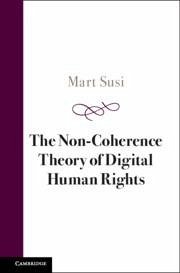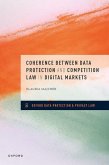Mart Susi
The Non-Coherence Theory of Digital Human Rights
Mart Susi
The Non-Coherence Theory of Digital Human Rights
- Gebundenes Buch
- Merkliste
- Auf die Merkliste
- Bewerten Bewerten
- Teilen
- Produkt teilen
- Produkterinnerung
- Produkterinnerung
"Susi offers a novel non-coherence theory of digital human rights. It explains the change in meaning and scope of human rights rules, principles, ideas and concepts, and the interrelationships and related actors, when moving from the physical domain into the online domain"--
Andere Kunden interessierten sich auch für
![International Economic Law in the Era of Datafication International Economic Law in the Era of Datafication]() Shin-Yi PengInternational Economic Law in the Era of Datafication114,99 €
Shin-Yi PengInternational Economic Law in the Era of Datafication114,99 €![Digital Health Care outside of Traditional Clinical Settings Digital Health Care outside of Traditional Clinical Settings]() Digital Health Care outside of Traditional Clinical Settings96,99 €
Digital Health Care outside of Traditional Clinical Settings96,99 €![The Cambridge Handbook of Facial Recognition in the Modern State The Cambridge Handbook of Facial Recognition in the Modern State]() The Cambridge Handbook of Facial Recognition in the Modern State200,99 €
The Cambridge Handbook of Facial Recognition in the Modern State200,99 €![International Human Rights International Human Rights]() Cher Weixia ChenInternational Human Rights101,99 €
Cher Weixia ChenInternational Human Rights101,99 €![The coherence of the European Union's external security action The coherence of the European Union's external security action]() Samar Ben BrahimThe coherence of the European Union's external security action55,99 €
Samar Ben BrahimThe coherence of the European Union's external security action55,99 €![The ASEAN Intergovernmental Commission on Human Rights The ASEAN Intergovernmental Commission on Human Rights]() Robin RamcharanThe ASEAN Intergovernmental Commission on Human Rights181,99 €
Robin RamcharanThe ASEAN Intergovernmental Commission on Human Rights181,99 €![Coherence Between Data Protection and Competition Law in Digital Markets Coherence Between Data Protection and Competition Law in Digital Markets]() Klaudia MajcherCoherence Between Data Protection and Competition Law in Digital Markets115,99 €
Klaudia MajcherCoherence Between Data Protection and Competition Law in Digital Markets115,99 €-
-
-
"Susi offers a novel non-coherence theory of digital human rights. It explains the change in meaning and scope of human rights rules, principles, ideas and concepts, and the interrelationships and related actors, when moving from the physical domain into the online domain"--
Produktdetails
- Produktdetails
- Verlag: Cambridge University Press
- Seitenzahl: 340
- Erscheinungstermin: 29. Februar 2024
- Englisch
- Abmessung: 235mm x 161mm x 24mm
- Gewicht: 592g
- ISBN-13: 9781009407700
- ISBN-10: 1009407708
- Artikelnr.: 69074094
- Herstellerkennzeichnung
- Libri GmbH
- Europaallee 1
- 36244 Bad Hersfeld
- gpsr@libri.de
- Verlag: Cambridge University Press
- Seitenzahl: 340
- Erscheinungstermin: 29. Februar 2024
- Englisch
- Abmessung: 235mm x 161mm x 24mm
- Gewicht: 592g
- ISBN-13: 9781009407700
- ISBN-10: 1009407708
- Artikelnr.: 69074094
- Herstellerkennzeichnung
- Libri GmbH
- Europaallee 1
- 36244 Bad Hersfeld
- gpsr@libri.de
Mart Susi is Professor of Human Rights Law at the School of Governance, Law and Society, Tallinn University. He has initiated several academic networks and projects involving above 100 academics from around the world and is Chair of Global Digital Human Rights Network.
Introduction: the distorted image
Part I. The Contextual Challenges and Purpose of The Non-Coherence Theory of Digital Human Rights: 1. Horizontal and vertical governance models and normativity
2. The ontological dimension-reflections on distorted images and normative fragmentation
3. The epistemic dimension-rhetoric by and recognition of multiple actors
4. On the controversy about the relative weight of rights
5. Constitutional entitlements to human rights in the digital domain
Part II. Reflections On Some Theories and Doctrines: 6. The doctrine of the sameness of rights online and offline
7. Claims of new internet-specific human rights
8. The capabilities approach
9. The frankfurt school and normative order of the internet
10. The articulation and critical review of self-normativity
11. The transversality principle (Teubner)
12. Network society approach (Castells)
Part III. The Core Elements of The Non-Coherence Theory: 13. Doctrinal changes in scope and the meaning of human
14. The variance principle and digital transparency
15. Legal certainty and uncertainty
16. On foreseeability and non-foreseeability
17. Reflections from the academic debate
Part IV. The Impact of The Non-Coherence Theory: 18. The e-state and fundamental rights
19. Proportionality deficit paradox
20. Automated systems and artificial intelligence
Part V. Internet Balancing Formula: 21. The Internet Balancing Formula
22. Robert Alexy's views on the internet balancing formula
23. Reply to Alexy critique
In lieu of the concluding remarks - the trailer for the monograph.
Part I. The Contextual Challenges and Purpose of The Non-Coherence Theory of Digital Human Rights: 1. Horizontal and vertical governance models and normativity
2. The ontological dimension-reflections on distorted images and normative fragmentation
3. The epistemic dimension-rhetoric by and recognition of multiple actors
4. On the controversy about the relative weight of rights
5. Constitutional entitlements to human rights in the digital domain
Part II. Reflections On Some Theories and Doctrines: 6. The doctrine of the sameness of rights online and offline
7. Claims of new internet-specific human rights
8. The capabilities approach
9. The frankfurt school and normative order of the internet
10. The articulation and critical review of self-normativity
11. The transversality principle (Teubner)
12. Network society approach (Castells)
Part III. The Core Elements of The Non-Coherence Theory: 13. Doctrinal changes in scope and the meaning of human
14. The variance principle and digital transparency
15. Legal certainty and uncertainty
16. On foreseeability and non-foreseeability
17. Reflections from the academic debate
Part IV. The Impact of The Non-Coherence Theory: 18. The e-state and fundamental rights
19. Proportionality deficit paradox
20. Automated systems and artificial intelligence
Part V. Internet Balancing Formula: 21. The Internet Balancing Formula
22. Robert Alexy's views on the internet balancing formula
23. Reply to Alexy critique
In lieu of the concluding remarks - the trailer for the monograph.
Introduction: the distorted image
Part I. The Contextual Challenges and Purpose of The Non-Coherence Theory of Digital Human Rights: 1. Horizontal and vertical governance models and normativity
2. The ontological dimension-reflections on distorted images and normative fragmentation
3. The epistemic dimension-rhetoric by and recognition of multiple actors
4. On the controversy about the relative weight of rights
5. Constitutional entitlements to human rights in the digital domain
Part II. Reflections On Some Theories and Doctrines: 6. The doctrine of the sameness of rights online and offline
7. Claims of new internet-specific human rights
8. The capabilities approach
9. The frankfurt school and normative order of the internet
10. The articulation and critical review of self-normativity
11. The transversality principle (Teubner)
12. Network society approach (Castells)
Part III. The Core Elements of The Non-Coherence Theory: 13. Doctrinal changes in scope and the meaning of human
14. The variance principle and digital transparency
15. Legal certainty and uncertainty
16. On foreseeability and non-foreseeability
17. Reflections from the academic debate
Part IV. The Impact of The Non-Coherence Theory: 18. The e-state and fundamental rights
19. Proportionality deficit paradox
20. Automated systems and artificial intelligence
Part V. Internet Balancing Formula: 21. The Internet Balancing Formula
22. Robert Alexy's views on the internet balancing formula
23. Reply to Alexy critique
In lieu of the concluding remarks - the trailer for the monograph.
Part I. The Contextual Challenges and Purpose of The Non-Coherence Theory of Digital Human Rights: 1. Horizontal and vertical governance models and normativity
2. The ontological dimension-reflections on distorted images and normative fragmentation
3. The epistemic dimension-rhetoric by and recognition of multiple actors
4. On the controversy about the relative weight of rights
5. Constitutional entitlements to human rights in the digital domain
Part II. Reflections On Some Theories and Doctrines: 6. The doctrine of the sameness of rights online and offline
7. Claims of new internet-specific human rights
8. The capabilities approach
9. The frankfurt school and normative order of the internet
10. The articulation and critical review of self-normativity
11. The transversality principle (Teubner)
12. Network society approach (Castells)
Part III. The Core Elements of The Non-Coherence Theory: 13. Doctrinal changes in scope and the meaning of human
14. The variance principle and digital transparency
15. Legal certainty and uncertainty
16. On foreseeability and non-foreseeability
17. Reflections from the academic debate
Part IV. The Impact of The Non-Coherence Theory: 18. The e-state and fundamental rights
19. Proportionality deficit paradox
20. Automated systems and artificial intelligence
Part V. Internet Balancing Formula: 21. The Internet Balancing Formula
22. Robert Alexy's views on the internet balancing formula
23. Reply to Alexy critique
In lieu of the concluding remarks - the trailer for the monograph.









